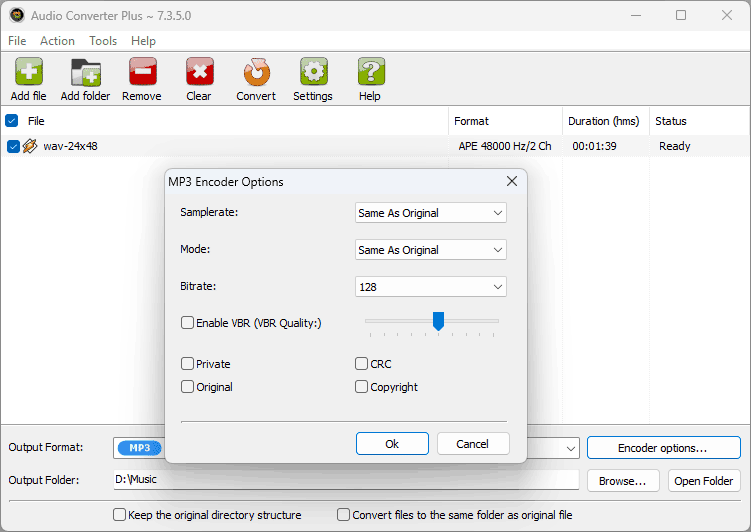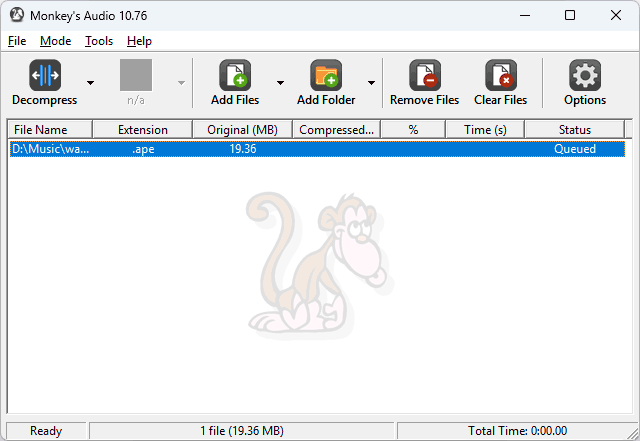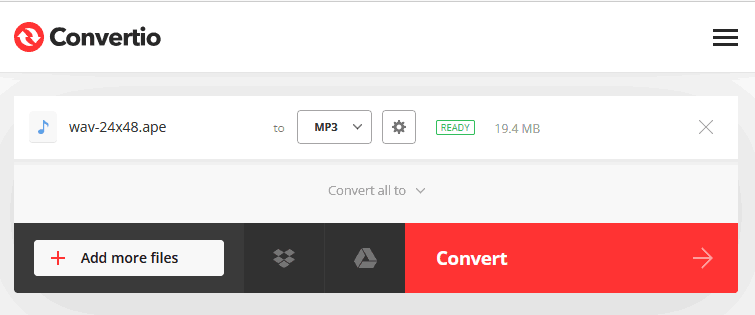
If you've ever tried playing an APE file on your phone, car stereo, or even a modern music player and found it wouldn’t work, you're not alone. APE — also known as Monkey's Audio — is a high-quality lossless format that was once popular among audiophiles and digital music collectors.
But while APE preserves every detail of the original recording, it’s not exactly easy to play outside of niche software. That’s where converting to MP3 comes in handy. It allows you to keep the music alive and usable — without needing special apps or plugins.
In this guide, we’ll explain what APE files are, why people choose to convert them, and how to do it using real tools like Audio Converter Plus, the official Monkey's Audio app, and online converters like Convertio.com.
1 What Are APE Files?
APE files are part of a lossless audio compression system developed by Monkey's Audio. They were designed to shrink music files without losing any quality — similar to FLAC, but with less support across platforms.
These files often contain:
- PCM (Pulse Code Modulation) audio data
- Samplerates up to 192 kHz
- Bit depths ranging from 8-bit to 32-bit
This makes APE ideal for archiving and mastering, especially if you're trying to preserve rare recordings or high-res music. But unlike FLAC, which gained wide support over time, APE never really caught on outside of specific communities.
Even though the format went open source later on, it had already lost ground to FLAC — and now most devices and media players don’t recognize APE natively. So unless you’re deep into retro audio formats, chances are you'll want to switch to something more flexible.
2 Why Would You Want to Convert APE to MP3?
There are several solid reasons why people make the move from APE to MP3:
Better Device CompatibilityMP3 plays almost everywhere — from smartphones to smart speakers to basic MP3 players. If you're moving your music library to a new device or sharing tracks with friends, switching to MP3 ensures everything works smoothly.
Easier File SharingSending an MP3 via email, messaging, or cloud storage doesn't require extra explanation. With APE, you might end up teaching someone how to install a codec just to hear your track.
Smaller File Sizes Without Major Quality LossWhile APE is already compressed, MP3 gives more portability — especially at higher bitrates like 192 kbps or 320 kbps. This is perfect for casual listening, voiceovers, or podcast editing.
Tag Support Is More ReliableAPE files can carry metadata like song titles and artist info, but many programs either misread or ignore those tags completely. MP3 handles metadata more consistently, making it easier to organize large collections.
Backward Compatibility IssuesOne serious problem with APE: files compressed with the new version of the official encoder are sometimes incorrectly decoded by third-party software, without giving an error. The codec developer has changed the file format, but left its version the same. As a result, there is a good chance that you will ruin your entire audio collection. Converting to MP3 avoids these problems — especially if you start from a clean source and avoid re-encoding multiple times.
And if you're working with CUE sheets that break entire albums down into individual tracks, converting to MP3 is easier than working with APE+APL combinations, which most apps simply don't support.
3 Audio Converter Plus – The Best Way for Clean Results
For Windows users who want full control, Audio Converter Plus offers a smooth and powerful way to convert APE files into MP3 with minimal effort. Support for a huge number of audio formats and, what is also important, metadata formats, will allow it to replace a whole set of specialized utilities.
 1. Download and install сonverter
1. Download and install сonverter
The download button above takes you to the latest version of the converter. The installation process itself should not cause any problems, you only need to select the folder for installing the program.
2. Add APE files to the conversion listAdd APE audio files from the File menu in batches. You can add several files at a time or a whole folder with an APE audio collection. The converter can scan all subdirectories if the corresponding option is selected in the settings panel.
3. Select the desired output folderIn the lower right field, you can see the Output Folder option. Click the Browse button to set the output path, which will be the destination folder for the converted MP3 files. If your APE files are carefully sorted into folders, then I strongly recommend choosing the option to keep the directory structure.
4. Set compression parametersSelect an MP3 encoder from the drop-down list and click "Encoder Options". Use the "Same as Original" settings to preserve the original audio format. If some files have a sampling rate higher than 48000 Hz, the program will automatically resample these files. To preserve high audio quality, I recommend choosing a bitrate of 192 kbps and higher, up to 320 kbps. Audio tags will be converted from APETag format to the standard MP3 file format ID3v2.
After that, all that remains is to start the conversion process and wait for the result. A little advice: never select the maximum number of conversion threads so that your computer does not lose responsiveness and you can work with other applications.
This method is ideal for working with large audio libraries and provides maximum control over the process. What is especially important, the converter even saves non-standard metadata from APEtags, including information about the tempo and key.
4 Monkey's Audio App – For Basic Conversion
The Monkey's Audio app is the original tool behind APE files. While it doesn’t export directly to MP3, it does let you decode APE to WAV first — which is the next step before encoding into MP3.

Here’s how it works:
- Open Monkey's Audio and load your APE file.
- Export it as WAV (this keeps full quality).
- Use a standard encoder like LAME MP3 Encoder or another converter to change the WAV into MP3.
This approach gives clean results, but takes an extra step compared to all-in-one converters. Still, if you're looking for a free option and don’t mind doing things manually, this is a solid starting point. If you plan to use this method often, you will need to download and install the Lame MP3 console encoder and add it to the application and set the compression parameters manually each time. Important: when using this method, you will lose all audio tags.
5 Online Converters – For One-Time Use
If you're not ready to install anything, browser-based tools like Convertio.com or its competitors offer a quick solution. Yes, it's not always free, but the limits should be enough for a few files.

How it works:
- Go to Convertio.com.
- Upload your APE file.
- Select MP3 as the target format.
- Wait a moment and download the result.
These services are great for quick conversions, especially on mobile or public computers. Just remember that uploading private recordings to unknown sites comes with risks — so always avoid sending sensitive content through untrusted platforms.
Also, online converters are generally not suitable for lossless audio because their file sizes are quite large. You will spend more time uploading than converting.
6 Frequently Asked Questions
Along with the large APE file I also received an APL file. What is it for?This is the equivalent of CUE files for MP3 files. It contains information about individual tracks within one large file. This is usually done when ripping an Audio CD.
Will I lose sound quality during conversion from APE to MP3?Since APE is lossless and MP3 is usually lossy, there will be some minor losses — but at 192–320 kbps, it’s hard to notice unless you're using studio-grade headphones. If you want to preserve bit precision, convert APE to FLAC.
Do I need special software to play APE files?Some media players like Foobar2000 support APE natively, but for most people, converting to MP3 is easier than installing extra tools.
Is there a way to convert a large archive of APE files in one go?Yes, tools like Audio Converter Plus allow you to perform batch conversion and can process tens of thousands of files in a single session.
Can I keep the original tags after conversion?Most decent converters preserve ID3 tags automatically, but always double-check your final files if tagging matters to your setup.
7 Conclusion
Converting APE files to MP3 is a smart move if you want your music to play anywhere — whether it’s on your phone, laptop, or old MP3 player. From archiving rare albums to preparing tracks for streaming or portable use, MP3 remains the most flexible choice.
From powerful desktop tools like Audio Converter Plus, to the Monkey's Audio suite, and quick fixes via online converters, there’s a method that fits every user.
So next time you come across an APE file collecting dust, don’t let it sit unused. Convert it to MP3 and bring your music back into rotation — wherever you listen.
